Home > Digitized Walters Manuscripts
This document is a tranformation of a TEI P5 XML manuscript description incorporating images. If you have trouble reading special or non-Latin characters on this page, please make sure you have appropriate Unicode fonts installed and an up-to-date web browser.
Walters Ms. W.567, Koran
Browse images (Browse images in a new window) | TEI in XML format
W.567
Koran
Vernacular: القرآن
This manuscript is a small illuminated single-volume copy of the Qurʾan, likely produced in Iran. A date is inscribed on the final page, which is interpreted as 1230 AH / 1814-5 CE (fol. 186b). The manuscript opens with an illuminated double-page incipit with the verses of chapter 1 (Sūrat al-fātiḥah) and the initial verses of chapter 2 (Sūrat al-baqarah), decorated with interlinear illumination (fols. 1b-2a). The text is in vocalized naskh script in black ink with reading marks in red and text divisions, such as thirty verses (juzʾ) or sixty verses (ḥizb), in the margins. Illuminated discs with colored dots separate the verses. Chapter headings are in riqāʿ script in red ink on a gold ground. The nineteenth-century lacquer binding with a floral composition on a gold field on the upper and lower boards seems to be contemporary with the manuscript. The insides of both boards are painted with a lobed yellow central medallion and pendants on an orange field.
Probably 1230 AH / 1814-5 CE; date forged to look like 1030? AH / 1621 CE
Iran
Book
Scriptural
The primary language in this manuscript is Arabic.
Paper
Cream laid paper
Foliation: 187
Catchwords: On versos, written obliquely outside the frame
Comments:
8.0 cm wide by 13.5 cm high
5.0 cm wide by 10.0 cm high
- Columns: 1
- Ruled lines: 21
- Framing lines in blue, black, and gold; outer double frame in black
- Title: al-Qurʾān
- Text note: Entire text in one volume; insertions in text on fols. 30b, 39b, 63b, 112a, 121a, 129a, and 179a; corrections on fols. 4b, 25a, and 51a
- Hand note: Text written in fully vocalized naskh script in black ink with reading marks (abbreviations) in red; chapter headings in riqāʿ script in red ink on gold ground; textual dividers, such as thirty verses (juzʾ) or sixty verses (ḥizb), inscribed in red ink in the margins
- Decoration note: Double-page illuminated incipit (fols. 1b-2a); chapter headings in riqāʿ script in red ink on gold ground; illuminated discs with colored dots separating verses; illuminated text frame in gold, black, and blue
Upper board outside:
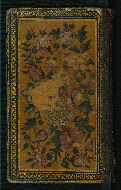
- Title: Binding
- Form: Binding
- Label: This nineteenth-century lacquer binding has a floral composition on a gold field on the upper and lower boards. It appears to be contemporary with the manuscript.
Upper board inside:
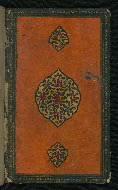
- Title: Inside of upper board
- Form: Binding
- Label: The insides of both upper and lower boards are painted with a lobed, yellow central medallion and pendants on an orange field. They may have been painted slightly later, possibly in India (Kashmir).
fol. 1b:

- Title: Right side of a double-page illuminated incipit
- Form: Incipit
- Text: Chapter 1 (Sūrat al-fātiḥah)
- Label: This is the right side of a double-page illuminated incipit. The verses of chapter 1 (Sūrat al-fātiḥah), are written in a vocalized naskh script in black ink with reading marks in red and interlinear gold decoration. The chapter headings and indication of number of verses are written in riqā‘ script in red ink on a gold ground in the upper rectangular panel. A wide illuminated border with blue half medallions and polychrome arabesques surrounds the text. The upper and lower panels and text area are separated by red frames with white dots and a narrow white border with black motifs.
fol. 2a:
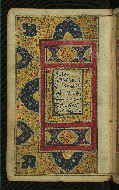
- Title: Left side of a double-page illuminated incipit
- Form: Incipit
- Text: Chapter 2 (Sūrat al-baqarah)
- Label: This is the left side of a double-page illuminated incipit. The verses of chapter 2 (Sūrat al-baqarah), are written in a vocalized naskh script in black ink with reading marks in red and interlinear gold decoration. The chapter headings and indication of number of verses are written in riqā‘ script in red ink on a gold ground in the upper rectangular panel. A wide illuminated border with blue half medallions and polychrome arabesques surrounds the text. The upper and lower panels and text area are separated by red frames with white dots and a narrow white border with black motifs.
fol. 2b:
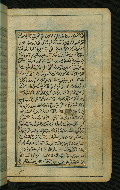
- Title: Text page with verses of chapter 2
- Form: Text page
- Text: Chapter 2 (Sūrat al-baqarah)
- Label: The text is written in vocalized naskh script in black ink with reading marks in red. Illuminated discs with colored dots separate the verses.
fol. 24b:
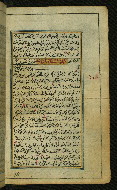
- Title: Text page with illuminated chapter heading for chapter 4
- Form: Chapter heading
- Text: Chapter 4 (Sūrat al-nisā')
- Label: This text page has an illuminated chapter heading for chapter 4 (Sūrat al-nisā') in riqāʿ script in red ink on a gold ground. The text is in vocalized naskh script in black ink with reading marks in red, and illuminated discs with colored dots separate the verses.
fol. 33a:
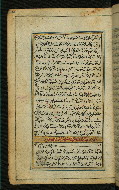
- Title: Text page with illuminated chapter heading for chapter 5
- Form: Chapter heading
- Text: Chapter 5 (Sūrat al-mā'idah)
- Label: This text page has an illuminated chapter heading for chapter 5 (Sūrat al-mā'idah), written in riqāʿ script in red ink on a gold ground. The text is in vocalized naskh script in black ink with reading marks in red, and illuminated discs with colored dots separate the verses.
fol. 65a:
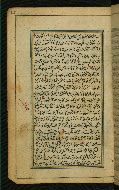
- Title: Text page with sixty-verse marker
- Form: Text page
- Text: Chapter 10 (Sūrat Yūnus)
- Label: The text is in vocalized naskh script in black ink with reading marks in red. In the margin at the right is the textual divider for sixty verses (ḥizb).
fol. 185b:
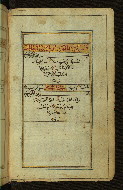
- Title: Text page with illuminated chapter headings for chapters 111 and 112
- Form: Chapter headings
- Text: Chapter 111 (Sūrat al-lahab) and chapter 112 (Sūrat al-ilkhās)
- Label: This text page has two illuminated chapter headings written in riqāʿ script in red ink on a gold ground for chapter 111 (Sūrat al-lahab) and chapter 112 (Sūrat al-ilkhās).
fol. 186a:
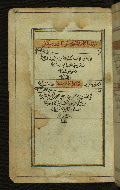
- Title: Text page of chapters 113 and 114
- Form: Text page
- Text: Chapter 113 (Sūrat al-falaq) and chapter 114 (Sūrat al-nās)
- Label: Chapters 113 (Sūrat al-falaq) and 114 (Sūrat al-nās) are written in vocalized naskh script in black ink with reading marks in red. A date is inscribed as 1030 AH / 1621 CE and is believed to have been forged. It is now interpreted as 1230 AH / 1814-5 CE.
The binding is not original.
Contemporary with manuscript; lacquer binding (no flap); floral composition on a gold ground enclosed by a gold frame with a repeating pattern on a black ground; insides of both upper and lower boards painted with a lobed, yellow central medallion and pendants with floral motifs on an orange ground, possibly in India (Kashmir)
Walters Art Museum, 1931, by Henry Walters bequest
Principal cataloger: Gacek, Adam
Catalogers: Landau, Amy; Smith, Sita
Copy editor: Bockrath, Diane
Conservators: Jewell, Stephanie; Quandt, Abigail
Contributors: Barrera, Christina; Emery, Doug; Herbert, Lynley; Noel, William; Simpson, Shreve; Tabritha, Ariel; Toth, Michael B.; Valle, Chiara
The Walters Art Museum
Licensed for use under Creative Commons Attribution-NonCommercial-ShareAlike 3.0 Unported Access Rights, http://creativecommons.org/licenses/by-nc-sa/3.0/legalcode. It is requested that copies of any published articles based on the information in this data set be sent to the curator of manuscripts, The Walters Art Museum, 600 North Charles Street, Baltimore MD 21201.